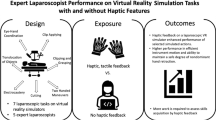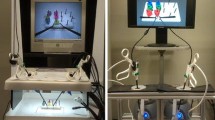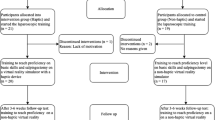Abstract
Introduction
Previous studies on the difference between physical, augmented and virtual reality (VR) simulation state that haptic feedback is an important feature in laparoscopic suturing simulation. Objective assessment is important to improve skills during training. This study focuses on the additive value of VR simulation for laparoscopic suturing training.
Methods
All participants of several European Association for Endoscopic Surgery (EAES)-approved laparoscopic skills courses (N = 45) filled out a questionnaire on their opinion on laparoscopic suturing training. Additionally, participants with little or no laparoscopic suturing experience were allotted to two groups: group A (N = 10), who started training on the box trainer and subsequently the VR simulator (SimSurgery), and group B (N = 10), who began on the VR simulator followed by the box. Finally, suturing and knot-tying skills were assessed by an expert observer, using a standard evaluation form (eight items on five-point-Likert scale). The same was done after the initial training on the box in group A, as a control.
Significant differences were calculated with the independent-sample t-test and the paired t-test.
Results
The total score of group A was higher than both group B and control (means of 30.80, 27.60, 28.20, respectively), but not significantly. The only tendency to a significant difference between group A and B was found in ‘taking proper bites’ (mean 4.10 versus 3.60, p = 0.054).
All the participants scored the features of the box trainer significantly higher than those of the VR simulator (p < 0.001), 46.7% was of the opinion that the box alone would be sufficient for laparoscopic suturing training.
Conclusion
From this study we can conclude that VR simulation does not have a significant additional value in laparoscopic suturing training, over traditional box trainers. One should consider that the future development in VR simulation should focus on basic skills and component tasks of procedural training in laparoscopic surgery, rather than laparoscopic suturing.







Similar content being viewed by others
References
Hamilton EC, Scott DJ, Fleming JB, Rege RV, Laycock R, Bergen PC, Tesfay ST, Jones DB (2002) Comparison of video trainer and virtual reality training systems on acquisition of laparoscopic skills. Surg Endosc 16:406–411
Aggarwal R, Moorthy K, Darzi A (2004) Laparoscopic skills training and assessment. Brit J Surg 91:1549–1558
Sickle Van KR (2005) Construct validation of the ProMIS simulator using a novel laparoscopic suturing task. Surg Endosc 19:1227–1231
Grantcharov TP, Kristiansen VB, Bendix J, Bardram L, Rosenberg J, Funch-Jensen P (2004) Randomized clinical trail of virtual reality simulation for laparoscopic skills training. Brit J Surg 91:146–150
Seymour N, Gallagher AG, Roman SA, O’Brien MK, Bansal VK, Andersen DK, Satava RM (2002) Virtual reality training improves operating room performance: results of a randomized, double-blinded study. Ann Surg 236:458–463
Ström P, Hedman L, Särnå L, Kjellin A, Wredmark T, Felländer-Tsai L (2006) Early exposure to haptic feedback enhances performance in surgical simulator training: a prospective randomized crossover study in surgical residents. Surg Endosc 20:1303–1308
Lehmann KS, Ritz JP, Maass H, Cakmak HK, Kuehnapfel UG, Germer CT, Bretthauer G, Buhr HJ (2005) A prospective randomized study to test the transfer of basic motor skills from virtual reality to physical reality in a comparable training setting. Ann Surg 241:442–449
Avgerinos DV, Goodell KH, Waxberg S, Cao CGL, Schwaitzberg SD. (2005) Comparison of the sensitivity of physical and virtual laparoscopic surgical training simulators to the user’s level of experience. Surg Endosc 19:1211–1215
Stefanidis D, Haluck R, Pham T, Dunne JB, Reinke T, Markley S, Korndorffer JR, Arellano P, Jones DB, Scott DJ. (2006) Construct and face validity and task workload for laparoscopic camera navigation: virtual reality versus videotrainer systems at the SAGES Learning Center. Surg Endosc DOI 10.1007/s00464-006-9112-9, December 6, 2006
Munz Y, Kumar BD, Moorthy K, Bann S, Darzi A (2004) Laparoscopic virtual reality and box trainers: is one superior to the other? Surg Endosc 18:485–494
Youngblood PL, Srivastava S, Curet M, Heinrichs WL, Dev P, Wren SM (2005) Comparison of training on two laparoscopic simulators and assessment of skills transfer to surgical performance. J Am Coll Surg 200:546–551
Fried GM, Feldman LS, Vassiliou MC, Frasier SA, Stanbridge DRN, Ghitulescu G, Andrew CG (2004) Proving the value of simulation in laparoscopic surgery. Ann Surg 240:518–528
Pearson AM, Gallagher AG, Rosser JC, Satava RM (2000) Evaluation of structured and quantitative training methods for teaching intracorporeal knot tying. Surg Endosc 16:130–137
Gonzales R, Bowers SP, Smith CD, Ramshaw BJ (2004) Does setting specific goals and providing feedback during training resulting better acquisition of laparoscopic skills? Am Surg 70:35–39
Madan AK, Frantzides CT, Shervin N, Tebbit CL (2003) Assessment of individual hand performance in box trainers compared to virtual reality trainers. Am Surg 69:1112–1114
Korndorfer JR, Dunne JB, Sierra R, Stefanidis D, Touchard CL, Scott DJ (2005) Simulator training for laparoscopic suturing using performance goals translates tot the operating room. J Am Coll Surg 201:23–29
Lamata P, Gómez EJ, Sánchez-Margallo FM, Lamata F, Antolín M, Rodríguez S (2005) Study of laparoscopic forces perception for defining simulation fidelity. Stud Health Technol Inform 119:288–292
Kim HK, Rattner DW, Srinivasan MA (2004) Virtual-reality-based laparoscopic surgical training: the role of simulation fidelity in haptic feedback. Comput Aided Surg 9:227–234
Maass H, Chantier BB, Cakmak HK, Trantakis C, Kuehnapfel UG (2003) Fundamentals of force feedback and application to a surgery simulator. Comput Aided Surg 8:283–291
Madan AK, Frantzides CT, Tebbit C, Quiros RM (2005) Participants’ opinions of laparoscopic training devices after a basic laparoscopic training course. Am J Surg 189:758–761
Carter FJ, Schijven MP, Aggerwal R, Grantcharow T, Francis NK, Hanna GB (2005) Consensus guidelines for validation of virtual reality surgical simulators. Surg Endosc 19:1523–1532
Schijven MP (2005) Virtual Reality Simulation for Laparoscopic Cholecystectomy: the process of validation and implementation in the surgical curriculum outlined. Optima Grafische Communicatie, Rotterdam
Acknowledgements
The authors would like to thank Cees Schot and Guy van Dael for their technical support. There are no conflicts of interest in this study. This study was partly funded by The Scientific Foundation of the Catharina Hospital Eindhoven, The Netherlands. One SurgicalSim Education Platform and two SimPort software packages were provided for this study by SimSurgery, Oslo, Norway. This study was carried out by objective researchers, who have no attachments with the industry.
Author information
Authors and Affiliations
Corresponding author
Rights and permissions
About this article
Cite this article
Botden, S.M.B.I., Torab, F., Buzink, S.N. et al. The importance of haptic feedback in laparoscopic suturing training and the additive value of virtual reality simulation. Surg Endosc 22, 1214–1222 (2008). https://doi.org/10.1007/s00464-007-9589-x
Received:
Revised:
Accepted:
Published:
Issue Date:
DOI: https://doi.org/10.1007/s00464-007-9589-x




